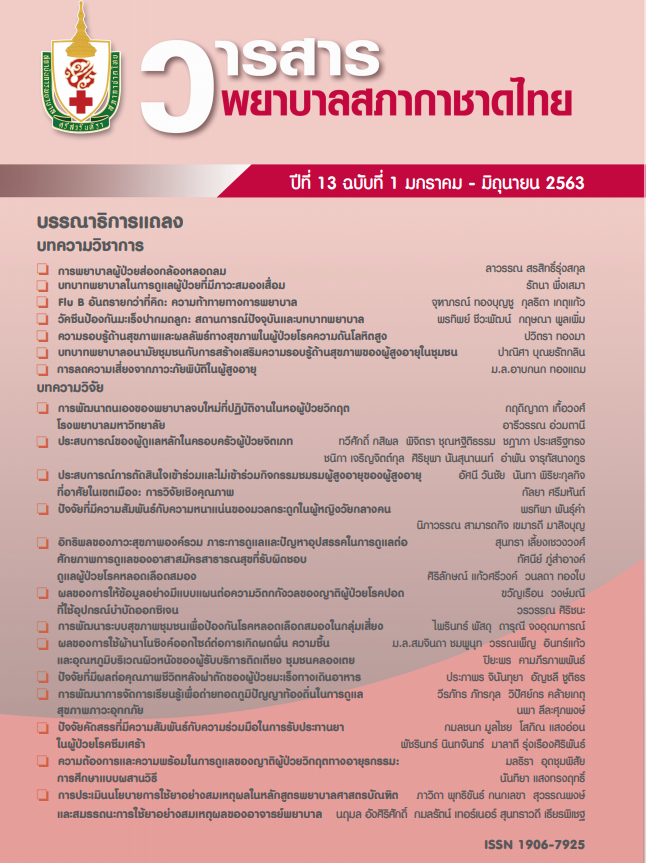Disaster Risk Reduction for Older People
Keywords:
older people, disaster, disaster risk reductionAbstract
ผู้สูงอายุมีความเปราะบางและเสี่ยงที่จะได้รับอันตรายในภาวะภัยพิบัติมากกว่าคนกลุ่มอื่น เนื่องจากภาวะสุขภาพและข้อจำกัดทางเศรษฐกิจและสังคมทำให้ยากต่อการเตรียมพร้อมและรับมือกับภัยพิบัติ ส่งผลให้เกิดการบาดเจ็บและเจ็บป่วยจากสาเหตุที่เกี่ยวเนื่องจากภัยพิบัติ พยาบาลเป็นบุคลากรด้านสุขภาพซึ่งมีบทบาทสำคัญในการดูแลผู้สูงอายุ กำลังเผชิญกับความท้าทายจากการที่โครงสร้างประชากรจะกลายเป็นสังคมผู้สูงอายุโดยสมบูรณ์ในอนาคตอันใกล้ และการเกิดภัยธรรมชาติที่ทวีความรุนแรงมากขึ้น การจัดการดูแลผู้สูงอายุในอนาคตจึงจำเป็นต้องครอบคลุมทั้งภาวะปกติและภัยพิบัติ และควรมีการสนับสนุนให้ผู้สูงอายุ ครอบครัว และชุมชนมีส่วนร่วมในการจัดการเพื่อลดความเสี่ยงจากภาวะภัยพิบัติด้วย เนื่องจากผู้สูงอายุส่วนใหญ่ยังสามารถดูแลตัวเองได้หากได้รับคำแนะนำให้เตรียมความพร้อมในการดูแลตัวเองอย่างเหมาะสมเมื่อเกิดภัยพิบัติ ในขณะเดียวกันพยาบาลซึ่งเป็นบุคลากรด้านสุขภาพที่มีบทบาทสำคัญในการดูแลผู้สูงอายุในภาวะภัยพิบัติจำเป็นที่จะต้องได้รับการพัฒนาสมรรถนะด้านการจัดการการดูแลในภาวะภัยพิบัติ เพื่อให้สามารถให้การพยาบาลที่ตอบสนองความต้องการทางสุขภาพของผู้สูงอายุได้ครอบคลุมในทุกระยะของภัยพิบัติ
References
2. Gibson MJ, Hayunga M. We can do better: lessons learned for protecting older persons in disaster [Internet]. 2006 [cited 2019 Jan 14]. Available from: http://assets.aarp.org/rgcenter/il/better.pdf
3. Helpage International. Promoting community-based disaster risk reduction, climate change adaptation and emergency response for older people and other vulnerable groups in ASEAN countries and Japan [Internet]. 2012 [cited 2019 Jan 14]. Available from: http://www.helpage.org/download/50ec33c52a831
4. Tamura K, Hayashi H, Kimura R. Clarifying suffering of the elderly in the 2004 Niigata flood and the 2004 mid-Niigata prefecture earthquake. Journal of Natural Disaster Science 2005;27:67-84.
5. Adams V, Kaufman SR, Van Hatturm T, Moody S. Aging disaster: mortality, vulnerability, and long-term recovery among Katrina survivors. Med Anthropol 2011;30(3):247-70.
6. Prasartkul P, editor. Situation of the Thai elderly, 2014. Bangkok: Amarin Printing & Publishing; 2015. (in Thai)
7. Institute for Population and Social Research, Mahidol University. Assessing and developing social assistance system in crisis situation. Bangkok; Nathaporn Plate; 2015. (in Thai)
8. McClelland E, Amlôt R, Rogers MB, Rubin GJ, Tesh J, Pearce JM. Psychological and physical impacts of extreme events on older adults: implications for communications. Disaster Med Public Health Prep 2017;11(1):127-34.
9. Cross KP, Clcero MX. Head-to-head comparison of disaster triage methods in pediatric, adult, and geriatric patients. Ann Emerg Med 2013;61(6):668-76.e7.
10. Wisitwong A, McMillan M. Management of flood victims: Chainat province, central Thailand. Nursing and Health Sci 2010;12:4-8.
11. Wu J, Xiao J, Li T, Li X, Sun H, Chow EP, et al. A cross-sectional survey on the health status and the health-related quality of life of the elderly after flood disaster in Bazhong city, Sichuan, China. BMC Public Health 2015;15:163
12. Siskind DJ, Sawyer E, Lee I, Lie DC, Martin-Khan M, Farrington J, et al. The mental health of older persons after human-induced disasters: a systematic review and meta-analysis of epidemiological data. Am J Geriatr Psychiatry 2016;24(5):379-88.
13. Parker G, Lie D, Siskind DJ, Martin-Khan M, Raphael B, Crompton D, et al. Mental health implications for older adults after natural disasters- -a systematic review and meta-analysis -CORRIGENDUM. Int Psychogeriatr 2016;28(1):21. doi: 10.1017/S1041610215001465.
14. American College of Emergency Physicians. Disaster planning toolkit for the elderly and special needs persons [Internet]. 2013 [cited 2015 Nov 3]. Available from: https://www.acep.org./uploasedFiles/ACEP/Practice_Resources/disaster_and_EMS/disaster_preparedness/Planning%20Toolkit%20for%20the%20Elderl%200613%281%29Pdf.
15. Baylor College of Medicine, American Medical Association. Recommendations for best practices in the management of elderly disaster victims [Internet]. 2006 [cited 2019 Jan 13]. Available from: http://www.bcm.edu/pdf/bestpractices.pdf.
16. Nick GA, Savoia E, Elqura L, Crowther MS, Cohen B, Leary M. Emergency preparedness for vulnerable populations: people with special health-care needs. Public Health Rep 2009;124(2):338-43.
17. HelpAge International. Older people in disasters and humanitarian crises: guidelines for best practice [Internet]. n.d. [cited 2019 Jan 13]. Available from:
http://www.handicap-international.fr/bibliographiehandicap/5CooperationInternationale/contextes_urgence/ Helpage_guidelines.pdf
18. Aldrich N, Benson WF. Disaster preparedness and the chronic disease needs of vulnerable older adults. Prev Chronic Dis 2008;5(1):A27.
19. Centers for Disease Control and Prevention. Identifying vulnerable older adults and legal options for increasing their protection during all-hazards emergencies: a cross-sector guide for states and communities. Atlanta: U.S. Department of Health and Human Services; 2012.
20. Gutman GM, Yon Y. Elder abuse and neglect in disasters: types, prevalence and research gaps. IJDRR 2014;10:38-47.
21. Somes J, Donatelli NS. Ethics and disasters involving geriatric patients. J Emerg Nurs 2014;40:493-6.
22. Florida Department of Elder Affairs. Disaster preparedness guide for elders [Internet]. n.d. [cited 2019 Jan 13]. Available from: http://elderaffairs.state.fl.us/english/EU2006/disaster06english.pdf.
23. Saltvedt I, Opdahl Mo ES, Fayers P, Kaasa S, Sletvold O. Reduced mortality in treating acutely sick, frail older patients in a geriatric evaluation and management unit. A prospective randomized trial. J Am Geriatr Soc 2002;50(5):792-8.
24. World Health Organization, International Council of Nursing. ICN framework of disaster nursing competencies. Geneva: WHO; 2009.
25. Hutton A, Veenema TG, Gebbie K. Review of the International council of nurses (ICN) framework of disaster nursing competencies. Prehosp Disaster Med 2016;31(6):680-3.
26. Jennings-Sanders A. Teaching disaster nursing by utilizing the Jennings Disaster Nursing Management Model. Nurse Educ Pract 2004;4(1):69-76.
Downloads
Published
Issue
Section
License
เนื้อหาบทความหรือข้อคิดเห็นต่างๆ ในวารสารพยาบาลสภากาชาดไทยนี้ เป็นความคิดเห็นของผู้เขียนบทความ ไม่ใช่ความเห็นของกองบรรณาธิการ หรือสถาบันการพยาบาลศรีสวรินทิรา สภากาชาดไทย






